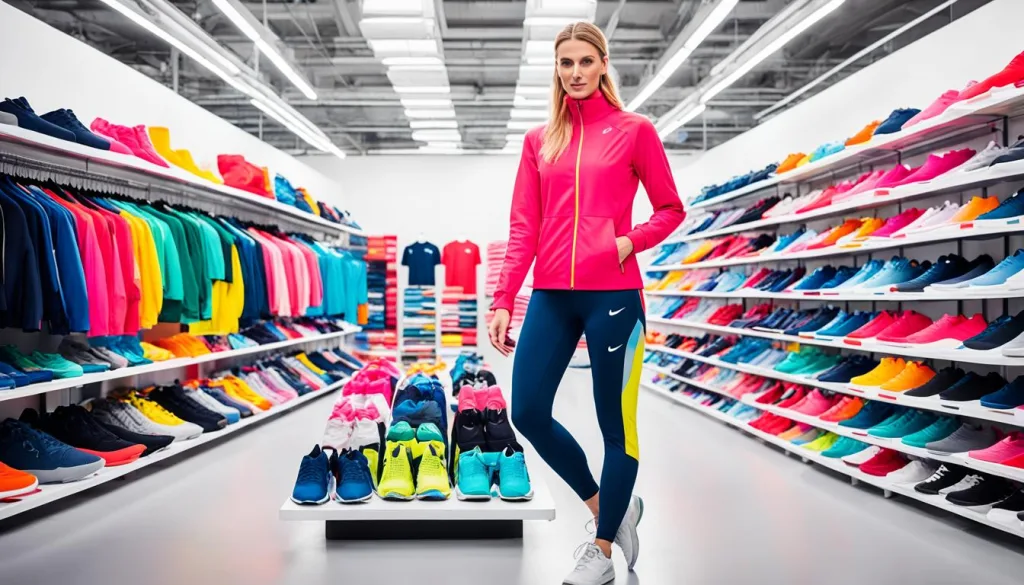How Transparency Affects the Supply Chain Dynamics of Sportswear Brands
Connect With Us Today
Consider us for your next production run. Why wait? Send us your questions here.
In the sportswear industry, clear info on where and how products are made is key. This is because a whopping 73% of shoppers are okay paying more if brands are open about their transparency in supply chain. Sadly, only 18% believe in brands that don’t prove their green efforts with third-party checks1. Being open about the supply chain helps gain customer trust. It also boosts a brand’s reputation and secures its future in the fast-changing sportswear scene.
Key Takeaways
- Supply chain transparency is increasingly pivotal to sportswear market success.
- Distrust in direct brand messaging is steering companies towards third-party verifications.
- Consumers are consciously investing more in transparency-endorsed products.
- The establishment of open directories offers a window into otherwise opaque supply chains.
- Ongoing funding highlights the growing importance of transparency initiatives such as the Open Apparel Registry and Sourcemap.
- Integrity in sportswear brand structure resounds through committed transparency at all levels.
Understanding the Fast Fashion Ecosystem and Transparency

The fast fashion ecosystem relies on making clothes quickly and cheaply to keep up with new trends. But, making and selling clothes so fast has hurt the environment and people’s lives. Making transparency in fast fashion a priority can change and improve the industry.
The clothing world is huge, making over USD 1.3 trillion and giving jobs to more than 300 million people2. Clothes production has grown quickly in the past 15 years, thanks to more people buying2. However, fast fashion has made us use our clothes much less, almost 40% less2.
Fashion uses a ton of resources that we can’t replace, about 98 million tonnes each year2. Switching to better methods could save a lot of money and help the planet2. Without change, fashion might use up to 26% of the carbon budget by 20502. In the US, clothes are not worn much before being thrown away, losing billions in value every year2.
Rental models are a new solution in the fast fashion world, reducing the need to always make new clothes2. These methods, along with openness about how clothes are made, can make fashion better for everyone and the Earth.
| Aspect of Fast Fashion | Current Impact | Potential with Transparency |
|---|---|---|
| Production Growth Rate | Has doubled in 15 years2 | More sustainable manufacturing practices |
| Utilization of Clothes | Decreased by 40%2 | Extending the life cycle of garments |
| Carbon Budget | Risks using 26% by 20502 | Reduced emissions through accountability |
| Economic Opportunity | USD 560 billion from circular systems2 | Growth in a circular economy |
| Rental Market Development | Leads to reduced demand for new production2 | Promotes sharing economy and reuse |
Making the fast fashion ecosystem more sustainable means being clear about how clothes are made. This transparency in fast fashion lets buyers choose clothes that are good for people and the planet. By understanding the true cost of fast fashion, we can push for a future that cares for all.
The Significance of Ethical Sourcing in the Sportswear Industry
Today, both sports fans and everyday buyers are focusing more on where their sportswear comes from. They care about ethical sourcing and its effect on the environment. Businesses have noticed and are changing how they work. They understand that being ethical is not just good for the planet but also meets what customers want and helps the industry last longer.
Environmental Impacts of Textile Production
The sportswear industry is trying hard to be more eco-friendly. They face challenges like reducing the harm to our planet from making clothes. Studies show that being open about how things are made helps win customers’ trust1. This openness can even boost sales.

Water Consumption and Chemical Usage
Using too much water and harmful chemicals in making clothes is bad for both nature and our health. That’s why clothing brands are looking closely at how they make things from start to finish. With tools like Sourcemap, companies including Ferrero and Mars1 are taking big steps to use water and chemicals more wisely.
Fighting Overproduction and Waste in Fashion
The Open Apparel Registry (OAR) helps fight too much production and waste in the fashion world1. Supported by groups like the Laudes Foundation1, OAR makes it clear how important openness is. It shows that to earn trust and last long in the business, companies need to be transparent.
There’s a big push for eco-friendly sports clothes nowadays. This push is expected to dramatically increase the market value to USD 142.61 billion by 20313. This growth points out how much people want sustainable choices in sportswear today.
How Transparency Affects the Supply Chain Dynamics of Sportswear Brands
More and more, shoppers want brands to be honest about how they make products. The transparency benefits in supply chain are changing the game in the sportswear world. A study by McKinsey and the Open Data Institute shows open data could be worth up to $5 trillion, showing big chances for honest brands1. Also, 73% of buyers would pay more for products from these transparent brands1. Fast fashion’s experiences show us that clear companies are seen as greener by customers4. Yet, only 18% of people believe when brands say they are sustainable. This highlights how crucial NGOs are in checking these claims1.
Case Studies of Leading Fast Fashion Retailers
Looking at successful brands, we see the importance of using natural and recycled materials. Girlfriend Collective and Patagonia lead by example in the industry4. Also, getting certifications like bluesign and Global Recycled Standards prove a brand’s real effort in being green4.
The Role of NGOs and Consumer Pressure on Transparency
Tools like the Open Apparel Registry (OAR) play a big role in making supply chains clearer. They give info on over 57,000 places in more than 120 countries1. These tools are trusted ways to see how transparent fast fashion is. OAR gets big grants to help make supply chains more open, showing how NGOs and donors help set standards1.
Evaluating the Transparency of Fast Retailing
New laws are bringing changes to how supply chains work. For example, Germany’s Supply Chain Act and the UK’s Modern Slavery Act ask for proper checks and open data use1. The US also refuses imports from Xinjiang due to concerns over human rights1. So, it’s important for brands to review their supply chains carefully. This helps them stay on the right side of the law and meet shopper demand for ethical goods4.
The table below provides a snapshot of sustainability practices in the sportswear industry.
| Brand | Transparency Practice | Material Sustainability | Certifications | Consumer Trust Level |
|---|---|---|---|---|
| Patagonia | Full disclosure on sourcing | Recycled materials | GOTS, bluesign | High |
| Girlfriend Collective | Detailed manufacturing process | Recycled polyester | Global Recycled Standard | High |
| Fast Retailing | Supply chain transparency initiatives | Natural and recycled fibers | Commitment to standards development | Moderate |
For full transparency benefits in the supply chain, firms need to use open-source data in what they do. A piece on how open-source data can fix fashion’s supply chains points out its importance. Companies like Sourcemap show that seeing the full supply chain helps meet goals and increases appeal to careful buyers14.
Supply Chain Transparency as a Catalyst for Change
The demand for sustainability in fashion is more urgent than ever. The industry is criticized for its environmental harm, highlighted by severe water pollution and the large amount of water used to grow cotton5. This situation offers a chance for supply chain transparency to lead to big changes. It’s vital to rethink current practices and see transparency as key for social and environmental well-being5. Pressure from consumers and NGOs is making the industry more accountable52.
In the fashion world, being open about supply chains is hard, especially when it comes to the smaller suppliers and sharing information about operations6. However, profitable companies that are influential are more likely to monitor their supply chains closely5. This motivates smaller companies to do the same. A company’s size affects how easily it can make positive changes5. This highlights how important it is for companies to commit to being more transparent.
The push for more transparency is gaining attention, starting important conversations about ethics. The fashion industry employs many, including a lot of young women6, which emphasizes the need for good working conditions. Calls for openness are not just about saving the environment. They also fight against child labor, forced labor, and low pay6. Supply chain transparency could start a new chapter for the industry, focusing on honesty, sustainability, and ethical awareness.
FAQ
How does transparency affect the supply chain dynamics of sportswear brands?
What is the relationship between fast fashion and transparency?
Why is ethical sourcing significant in the sportswear industry?
What are some case studies of leading fast fashion retailers regarding transparency?
What role do NGOs and consumer pressure play in advocating for transparency?
How can supply chain transparency act as a catalyst for change in the sportswear industry?
Source Links
- https://www.forbes.com/sites/amynguyen/2021/05/13/open-source-data-could-fix-fashions-supply-chains-heres-how/
- https://www.ellenmacarthurfoundation.org/fashion-and-the-circular-economy-deep-dive
- https://www.skyquestt.com/report/sustainable-athleisure-market
- https://www.cnn.com/cnn-underscored/fashion/best-sustainable-activewear-brands
- https://www.mdpi.com/2071-1050/14/18/11520
- https://www.mdpi.com/2071-1050/12/11/4429
Latest News
How Collaboration Shapes Consumer Preferences in Sportswear
Navigating Consumer Rights and Warranties in Sportswear Sales
Artificial Intelligence in Fashion Forecasting and Trend Analysis
The Shift Towards Inclusive Sizing in Sportswear: Consumer Reactions
The Global Expansion of Luxury Sportswear Brands
From Sketch to Gym: The Design Process of Fashionable Sportswear
Understanding the Role of Trade Associations in Sportswear Compliance
How Economic Trends Influence Consumer Spending on Sportswear
Learning from Successful Global Market Entries
Best Practices for Managing Cross-Cultural Teams
Using Technology to Fight Counterfeit Fashion Products
Carbon Nanotube Fabrics for Superior Strength and Flexibility
The Growth of Fitness Tracking Apparel in Health and Wellness
Exploring the Influence of Social Proof in Sportswear Purchasing
Strategies for Managing Compliance in a Multinational Operation
Trends in Global Footwear: Performance Meets Lifestyle
The Role of Artificial Intelligence in Tracking Supply Chain Operations
Evaluating the Success of Sportswear Collaborative Projects
Evaluating the Potential of Emerging Markets
Global Shifts Towards Gender-Neutral Sportswear
Share This Article
Latest Articles



















